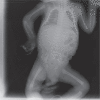The efficiency of cinacalcet treatment in delaying parathyroidectomy in a case with neonatal severe hyperparathyroidism caused by homozygous mutation in the CASR gene
- PMID: 35399047
- PMCID: PMC10214968
- DOI: 10.5114/pedm.2022.115070
The efficiency of cinacalcet treatment in delaying parathyroidectomy in a case with neonatal severe hyperparathyroidism caused by homozygous mutation in the CASR gene
Abstract
Neonatal severe hyperparathyroidism (NSHPT) causes severe hypercalcaemia, metabolic bone disease, and potential neurodevelopmental deficits, all of which can be life-threatening. The use of calcimimetic agents can prevent or delay technically difficult parathyroidectomy in the newborn period. We present a 6-day-old male infant who presented with poor feeding, weight loss, and severe hypotonia. His total serum calcium and parathyroid hormone levels were very high (23.6 mg/dl and 1120 ng/dl, respectively). Based on these findings, the patient was diagnosed with NSHPT and was started on cinacalcet therapy until the genetic analysis results were available. Genetic analysis revealed a previously reported homozygous mutation in the CASR gene that was unresponsive to cinacalcet therapy in the literature. However, a normocalcaemic state unexpectantly occurred, which could be maintained with low calcium formula and cinacalcet therapy up to 13 months of age in the patient. Nevertheless, hypercalcaemia developed 2 months after he started a normal calcium-containing diet. Therefore, the patient underwent total parathyroidectomy at 17 months of age. We would like to emphasize, in light of this case, that cinacalcet treatment may be considered as first-line therapy for delaying parathyroidectomy in all cases with NSHPT, even in those who have an unresponsive cinacalcet CASR gene mutation.
Keywords: CASR.; cinacalcet; severe hyperparathyroidism.
Conflict of interest statement
none declared.
Figures




References
-
- Hendy GN, D’Souza-Li L, Yang B, et al. . Mutations of the calcium-sensing receptor (CASR) in familial hypocalciuric hypercalcemia, neonatal severe hyperparathyroidism, and autosomal dominanthypocalcemia. Hum Mutat 2000; 16: 281–296.10.1002/1098-1004(200010)16:4<281::AID-HUMU1>3.0.CO;2-A - DOI - PubMed
-
- Richards S, Aziz N, Bale S, et al. . ACMG Laboratory Quality Assurance Committee . Standards and guidelines for the interpretation of sequence variants: a joint consensus recommendation of the American College of Medical Genetics and Genomics and the Association for Molecular Pathology. Genet Med 2015; 17: 405–424. 10.1038/gim.2015.30 - DOI - PMC - PubMed
Publication types
MeSH terms
Substances
Supplementary concepts
LinkOut - more resources
Full Text Sources
